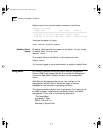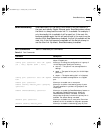
Load Sharing 3-15
Load Sharing Load sharing with the Switch 3800 allows you to increase bandwidth
and resilience by using a group of ports to carry traffic in parallel
between Switches. The sharing algorithm allows the Switch to use
multiple ports as a single logical port. For example, VLANs see the
load-sharing group as a single virtual port. The algorithm also
guarantees packet sequencing between clients.
If a port in a load-sharing group fails, traffic is redistributed to the
remaining ports in the load-sharing group. If the failed port becomes
active again, traffic is redistributed to include that port.
Load sharing is most useful in cases where the traffic transmitted from
the Switch to the load-sharing group is sourced from an equal or
greater number of ports on the Switch. For example, traffic transmitted
to a 2-port load-sharing group should originate from a minimum of
two other ports on the same Switch.
This feature is supported between Switch 3800 Switches only, but may
be compatible with third-party trunking or sharing algorithms.
Configuring Load
Sharing
To set up the Switch 3800 to load share among ports, you must create
a load-sharing group of ports. Load-sharing groups are defined
according to the following rules:
■ Ports on the Switch are divided into groups of two or four.
■ Ports in a load-sharing group must be contiguous.
■ Valid port combinations are distinguished by the outlined boxes in
Table 3-7.
■ The first port in the load-sharing group is configured to be the
master logical port. This is the reference port used in configuration
commands. It can be thought of as the virtual port representing the
entire port group.
Table 3-7 shows the allowable load-sharing port group combinations
for the Switch 3800.
SW3800.BK Page 15 Tuesday, May 5, 1998 5:20 PM


















